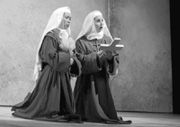THE FIRST SENTENCE of the Francis Poulenc article in Grove’s Dictionary of Music and Musicians clearly states the problem: “During the first half of his career, the simplicity and directness of his writing led many critics away from any thought of him as a serious composer.” Poulenc is still seen as the 20th century’s musical jester; his music is neat and stylish, perhaps, but frivolous and hardly innovative. Though he never shied from providing light entertainment, when he chose to mine more deeply (Organ Concerto or the choral song-cycle Figure Humaine), the results were breathtakingly beautiful.
Dialogues of the Carmelites
UW campus, Meany Hall November 8-12
Last Wednesday, the University of Washington’s School of Music opened a three-performance run of Poulenc’s Dialogues of the Carmelites, another work in this vein and one of the most affecting and remarkable operas of the postwar era.
Set at the height of the Terror during the French Revolution, Dialogues tells of a young noblewoman, Blanche de la Force, who enters a convent. She’s no larger-than-life Carmen or Tosca, but a humbly pious yet conflicted woman, who makes a powerfully compelling operatic heroine. In this complex role, Fumi Takiguchi sang securely and was truly moving; along with Susan Adkins as the physically and theologically anguished Mother Superior, the two made the strongest impressions out of the cast.
Nuns always look picturesque and imposing on stage, but David C. Morris’ starkly elegant set, with its movable parchment-colored walls printed with Latin texts, enhanced their presence.
In outline, the story is nearly incident-free: The Mother Superior dies, and the nuns are arrested and executed as counterrevolutionaries. The libretto, by Georges Bernanos, was originally intended as a film script, and Poulenc’s setting retains, interestingly, a cinematic structure of short “blackout” scenes separated by orchestral interludes. Made out of dialogues instead of rhymed or metered verse, the opera is, nevertheless, flowingly lyrical.
ITS TENSION RISES steadily, prompting several “How does he do it?” questions. Poulenc’s harmonic style is based on simple chords, but it’s what he does with them that counts: He artfully combines two or more triads at once, sets them over a clashing bass line, or adds extra notes (such as lounge music-like sixths) to create an atmosphere at once homely and spicy, devout and lurid. The opera’s melodramatic high points are not belt-it-out flights of emotion, but somber liturgical set pieces: an “Ave Maria,” an “Ave Verum,” and the closing “Salve Regina.”
The increasing tension climaxes in the bone-chilling scaffold scene: The condemned sisters approach their execution singing, and with each slice of the offstage guillotine, a voice drops out, leaving Blanche alone to die in midphrase. For wringing maximum dramatic effect out of the simplest means, there’s no other moment in opera like it.
Claudia Zahn’s direction works beautifully. As in the UW’s magical H䮳el and Gretel a couple of seasons ago, she shows her ability to make stunning drama out of the simplest movements, gestures, and delivery.







